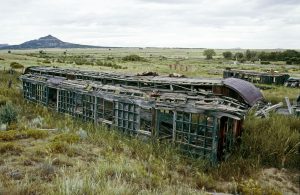When her train clattered over the Vermejo River, 12-year-old Martha Betty Putnam stopped briefly at Colfax, N.M., a town boasting two railroads and 100 or more people wishing coal to be big business again. Here she crossed the Dawson Railway, a steel river of coal flowing from the Sangre de Cristo Mountains toward distant copper smelters. The raw beauty of northeast New Mexico — tall timber on her right, infinite range on her left — awed the Illinois girl aboard the Rocky Mountain & Santa Fe Railroad as the steam engine in front chuffed along the Santa Fe Trail toward Cimarron, once the seat of empire. From there staccato exhaust echoed into the Sangres before Martha Betty stepped down at the year-old Cimarroncita Ranch Camp for Girls to spend the summer of 1932.
The predecessor railroad boasted Pacific in its name, envisioned Ute Park a mile beyond the camp as a destination resort, and blasted a tunnel higher up for its next move into the Moreno Valley. With abundant timber, coal and other natural resources ripe for exploitation, boosters in the Cimarron News and Cimarron Citizen in 1911 crowed, “There does not seem to be any way to keep the Cimarron country from becoming the Florida, the southern California, and the Klondike of New Mexico all rolled into one.” Instead the railroad ran short of cash and ambition at Ute Park dashing the steam-driven aspirations of hopeful Taos 40 twisted miles farther west.

Saltpeter Mountain rises to the north of Colfax, N.M. in October 1995. The Rocky Mountain & Santa Fe Railroad approached over the horizon from Raton and crossed the Vermejo River here. Warning signals on the highway mark the former Dawson Railway still following the river to Dawson and York Canyon. Photo © William P. Diven (Click to enlarge)
